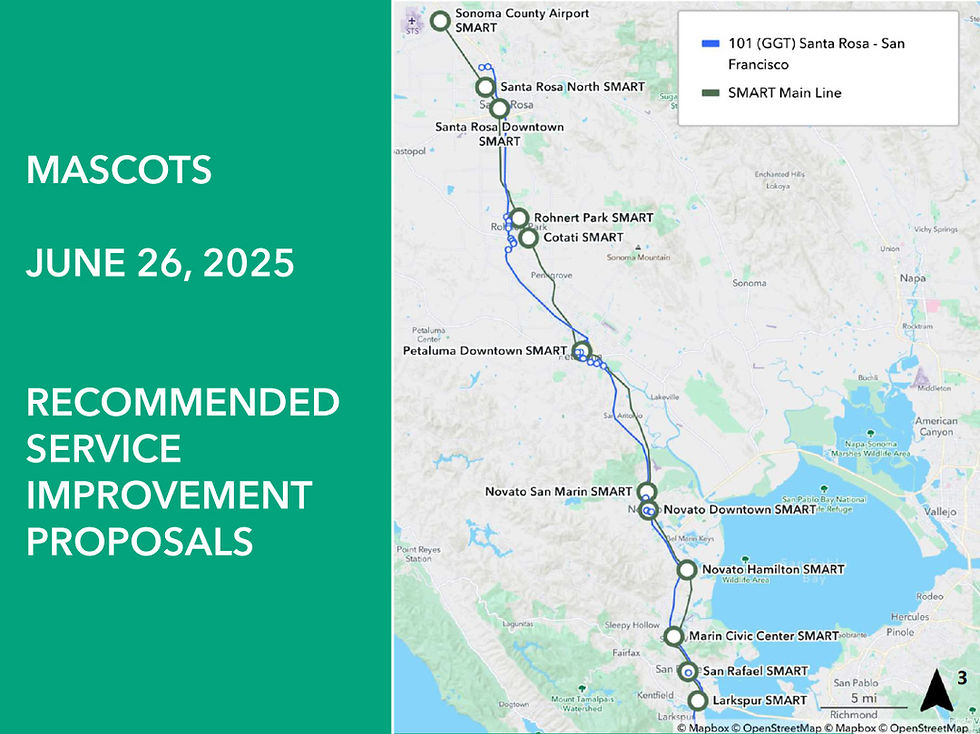PRESS DEMOCRAT SAYS - Yes on Measure I: Don’t derail SMART train
- Friends of Smart
- Feb 2, 2020
- 3 min read
Sunday, February 2, 2020

Imagine this: An unconventional mass transit system, up and running for just a short time, seeks an infusion of cash, warning that it might otherwise need to shut down.The general manager draws a big salary, and critics are demanding his scalp. Have you figured out what we’re talking about?
If you guessed BART, you’re right.
In 1974, after an investment of $1.6 billion and less than two years after starting operations, the nation’s first new rail system since the 1920s was, by its own accounting, on the verge of failure, and some prominent Bay Area voices were cheerleading for its demise.
You know how that story turned out, so let’s talk about SMART.
The suburban rail startup has had its share of trouble, some of it self-inflicted.
But a little more than two years after restoring passenger rail to the North Bay for the first time in six decades:
■ SMART’s weekday ridership is growing steadily, up 4.2% during its second full year of service and another 4.2% in the first quarter of its third year of service.
■ Trains are now running every 30 minutes during commute hours.
■ Service extends to Larkspur, where riders can catch a ferry across the bay.
■ Service to Windsor — the next milestone — will come as early as next year.
The price tag: $620 million. Not a bad return on $298 million in sales tax revenue.
To maintain its momentum, SMART is asking for help — not a tax increase, a 30-year extension of the quarter-cent sales tax approved by North Bay voters in 2008. That would allow SMART to restructure its bond debt to free up revenue for operations and, eventually, to fulfill the promise of service to Healdsburg and Cloverdale.
Measure I on the March 3 ballot is the government equivalent of refinancing a mortgage to add a room or pay college expenses.
Even SMART’s critics concede that the North Bay’s commuter rail agency was underfunded from the start. Yet they ignore its success leveraging other funding to overcome much of the shortfall.
The other arguments against Measure I are mostly recycled from the 2008 campaign and an unsuccessful effort in 2011 to overturn voter approval of the commuter rail system.
Yes, there still is traffic on Highway 101 at rush hour. Yes, you can find a seat on most SMART trains. Yes, fares are subsidized. So is practically every other mass transit system in the world. So are highways. Taxpayers have spent upwards of $1 billion widening Highway 101. Did we already mention there’s still traffic at rush hour?
SMART isn’t without its faults, especially a tendency to be insular, even secretive. As we’ve said previously, SMART’s excuses for withholding ridership data were preposterous. And, compared to BART and Caltrain, fares are
too high and pass options are too limited.
Those problems can be solved without undercutting SMART’s promise.
SMART is a long-term investment for the North Bay, and its success is a necessity — for environmental reasons and economic reasons.
Climate change is an undeniable fact. To adapt, we must cut greenhouse gases. That means getting people out of cars. And that requires convenient transit options and a shift from sprawl development to clustering housing and jobs along transit corridors. SMART is the hub of a regional transit system that will make that transformation possible in the North Bay.
A half-century after its rocky start, BART’s is struggling to meet demands to expand service to more places. SMART is just getting started. Imagine where it can be in 50 years.
The Press Democrat recommends a yes vote on Measure I.



Comments